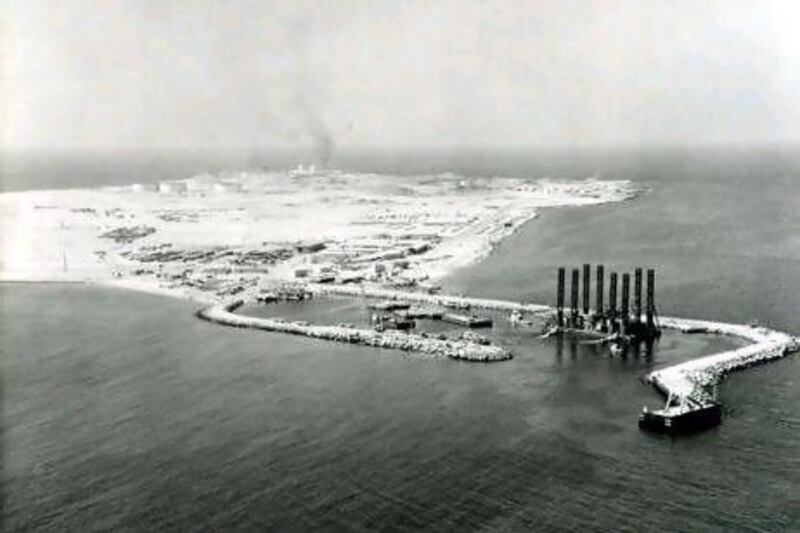Have you looked out to sea lately and seen the parade of tankers and cargo ships on the horizon? And the ports teeming with containers?
And, of course, in the city, the gleaming office towers, the motorways, the traffic congestion, the hotels and the restaurants.
It's hard to believe that a few score years ago, the emirates that now comprise the UAE were undeveloped with economies largely based on pearl production, fishing, agriculture and herding.
In the late 1920s, when the world market for the Gulf's high-quality pearls was destroyed mainly due to the Japanese invention of cultured pearls and the global depression, the already poor emirates fell upon even harder times.
Their fate turned just before the Second World War when the idea emerged that there could be oil under their deserts.
In the early 1930s, the first geological survey was conducted in Abu Dhabi under a concession granting all the onshore oil rights to a consortium of international oil companies consisting of Petroleum Development Company (PDC) - Trucial Coast, a subsidiary of the Iraq Petroleum Company, itself a joint venture of several oil majors, including BP, Shell, Total, and before they merged in 1999, Exxon and Mobil.
The exploration works were put on hold during the war but were resumed in early 1950, when the first survey well was drilled in Ras Sadr.
In 1953, an oil company set up by the London millionaire William Knox D'Arcy in the early 1900s, acquired the concession, passing it on two years later to Abu Dhabi Marine Areas (ADMA), owned initially by BP and a French firm that would later become Total.
In 1958, ADMA became the first company to discover off-shore oil in commercial quantities - at Umm Shaif close to Das Island. In the same year, PDC discovered the onshore Bab oil field followed by the discovery of the Bu Hasa field in 1962. The export of crude oil began from an oil-export terminal on Das Island in 1962, the same year that Abu Dhabi joined the family of oil exporters and its rapid transformation began.
Today, the UAE's proven oil reserves stand at approximately 98 billion barrels, representing just under 10 per cent of total world oil reserves. This places the UAE as the fourth-largest Opec producer after Saudi Arabia, Iran and Venezuela.
While oil has underpinned the development of the UAE, there is no doubt that natural gas is also playing an increasing role.
Abu Dhabi holds almost 90 per cent of the UAE's reserves of gas, although most of it is sour and relatively expensive to produce.
Abu Dhabi was one of the first in the region to realise the value of gas and instead of flaring it off, built a liquefied natural gas (LNG) plant on Das Island in 1977 to process associated gas and produce small amounts of liquefied petroleum gas, pentane and sulphur.
Today, the UAE's natural gas reserves are 212 trillion cubic feet, the fifth-largest in the world. The largest reserves, amounting to 196 trillion cubic feet, are located in Abu Dhabi, where the natural gas reservoirs beneath Umm Shaif and Abu Al Bukhush oil fields rank among the world's largest.
In addition to owning vast reserves of its own gas, the UAE is also positioning itself as a hub from which to supply a network that should benefit the entire Gulf region. A fine example of this is the Dolphin Project, which is the GCC's first cross-border refined gas transmission project, built in 1999, to connect Qatar, UAE and Oman.
As the UAE's economy continues to grow, the demand for energy will grow, too. The country's leaders are tasked with ensuring that there is enough energy to secure the UAE's future.
The greatest challenge is to find new sources of energy, especially during peak summer periods.
The UAE heavily depends on natural gas as the primary fuel for electricity generation.
Due to the quality of its own gas, which makes it too expensive to produce for now, the country is importing gas in liquid form to help with its surging summer demand.
With a floating storage and regasification unit on stream and the announcement of the construction of an LNG regasification plant in Fujairah, the Emirates is becoming a significant buyer of LNG, which will not only help the country in facilitating its growth but also strengthen its role on the world's oil and gas stage.
In less than four decades, the UAE has transformed from a culture reliant on the pearl and fishing trade to one of the major players in the international oil and gas market.
There is no doubt that oil and gas will continue to make a significant contribution to the UAE's economic growth, in ways the pearl divers could never have imagined.
Robert Jordan is Partner in Charge of the Middle East Practice of the international law firm Baker Botts LLP and is the former US Ambassador to Saudi Arabia. The author wishes to thank his colleague, Sofia Sattarova, for her assistance in preparing this article





